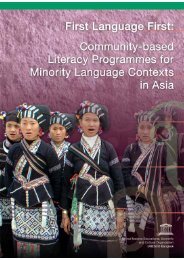Part II.pdf - MTB-MLE Network
Part II.pdf - MTB-MLE Network
Part II.pdf - MTB-MLE Network
Create successful ePaper yourself
Turn your PDF publications into a flip-book with our unique Google optimized e-Paper software.
Representation in elected bodies<br />
Each ethnic group has its own internal organization to perform their socio-political activities at<br />
village and regional levels. Positions in these tribal organizations are hereditary, and often in<br />
a state of disorganization.<br />
Until now, a very few – from ethnic minority communities living in the plains – have contested in<br />
general elections for parliament, or at the district, sub-district and union levels. Ethnic minority<br />
people in the Northwest, however, are distant from both local and national politics.<br />
Education<br />
An extremely low level of literacy prevails in the tribal communities. According to the 1991 Census,<br />
only 14.1% are literate. The female literacy rate is only 7.41% compared to 20.5% male literacy.<br />
(Biponna Bhumija by M. Kamal & A. Kibria)<br />
In both the government and non-government schools, tribal children aged between 6 to 10 years<br />
are admitted. After some time, however, they tend to drop out of school due to cultural and language<br />
problems. The enrolment rate of tribal children in primary schools is much lower than non-tribal<br />
children.<br />
In government and non-government schools and literacy classes, the medium of instruction is Bengali<br />
(the national language). There is no provision for using tribal language in these schools. A negligible<br />
number of teachers from indigenous communities are recruited in the government/non-government<br />
schools and colleges.<br />
Indigenous people live in remote villages, and often they are far from the government/non-government<br />
schools. Children have to walk many miles to get to the school. On average, they have to walk 3<br />
to 5 km. There are few government schemes related to indigenous literacy and education. There<br />
are quotas assigned to admission numbers, scholarships and the teaching profession, but these are<br />
not maintained properly.<br />
In the northwest plains of Bangladesh, the indigenous people have formed a political platform called<br />
Jatio Adivashi Parishad in order to address their socio-political issues.<br />
The government allocates approximately 6 lac taka to the indigenous inhabitants of upozilas 1 for<br />
their educational, as well as cultural, development.<br />
The relationship between the tribal and non-tribal people is often strained due to socio-economic<br />
and cultural exploitation, abuse of human rights, forced eviction from their homesteads and other<br />
causes. Through this insecurity in socio-economic and cultural life, indigenous peoples have been<br />
pushed to the margins of society and have experienced powerlessness. Thus, on many levels, the<br />
tribal people are isolated from wider society.<br />
1<br />
“Upazilla” means sub-district.<br />
141
















